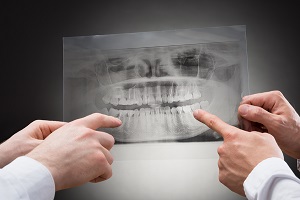
by Dr. Jacqueline S. Allen | Jun 28, 2016 | Blog, Endodontics, Patients, Phoenix Endodontic Group
 Phoenix Endodontic Group has been using an online patient referral system since 2005. That’s right – for the last 11 years, we have offered our referring dentists the ease and convenience of online referrals and case management for patients sent to our office for endodontic treatment.
Phoenix Endodontic Group has been using an online patient referral system since 2005. That’s right – for the last 11 years, we have offered our referring dentists the ease and convenience of online referrals and case management for patients sent to our office for endodontic treatment.
Back in 2005, online referrals were a difficult concept for Phoenix dentists to come around to. The old pen-and-paper method worked just fine before, but the explosive use of technology, along with tighter HIPPA requirements has made utilizing an online referral system a “must” for dental offices in Phoenix. “The rest of the world has finally caught up with our capabilities,” said Kevin G. Conroy, Operations Manager at Phoenix Endodontic Group.
Simply put, from the start of the referral process to the end, when a final report is generated, Phoenix Endodontic Group’s TDO software handles the communication between offices seamlessly. The referring office has its unique sign in to a HIPPA Compliant web portal to exchange patient information directly with our office. There is no need for secure emails because no patient information is sent via email.
Enhancements to this system are ongoing, and there are many benefits for the Phoenix dentist office that uses our referral system:
- Saves time — a referral can be made before the patient leaves the general dentist’s office – there are no hold time or delays.
- Convenience — no more looking for paper referral slips, which sometimes get misplaced by patients prior to making an appointment.
- Accuracy — not all doctors have the best handwriting, so typing in the specifics of a referred case makes misinterpretation less likely.
- HIPPA Compliant — using online referrals eliminates the risk of a potential privacy violation.
The 21st century has changed the way we all conduct business. At Phoenix Endodontic Group, we are always interested in utilizing best practices for our referring offices and patients alike.

by Dr. Jacqueline S. Allen | Jun 14, 2016 | Blog, Endodontics, Endodontist, Root Canal
 Despite a recent increase in awareness of the role of endodontists, root canal therapy is still feared by more than half (54%) of all Americans, according to a 2014 survey. This is truly unfortunate because the procedure has great potential to improve a dental patient’s oral health and well-being.
Despite a recent increase in awareness of the role of endodontists, root canal therapy is still feared by more than half (54%) of all Americans, according to a 2014 survey. This is truly unfortunate because the procedure has great potential to improve a dental patient’s oral health and well-being.
Here are just a few benefits that a patient can receive when he or she undergoes root canal therapy.
Benefits of Root Canal Therapy
- Reduces or eliminates pain from a toothache. Root canals can often successfully treat tooth pain symptoms, as well as symptoms related to infected tooth pulp, such as tenderness, foul smell or taste, and swelling in the gum and jaw tissue surrounding a tooth.
- Saves your natural tooth. A root canal removes and replaces the damaged and infected pulp from the inside of your tooth and allows it to function normally after a restoration is placed on the tooth.
- Improves the appearance of your tooth. A custom-made crown is often placed over the treated tooth. This can improve the appearance of a tooth that’s been cracked or infected.
- It’s a simple, relatively quick procedure. Root canal therapy typically only involves one or two appointments, including the installment of the final restoration.
- It allows you to speak, chew and eat normally. By removing the source of pain and protecting the natural tooth structure, a root canal allows you to keep using your tooth the way nature intended you to.
- Reduces the need for future dental work. By stabilizing the tooth and removing dangerous infections, root canals can prevent the need for tooth extractions, dental implants, and dentures. Many teeth that receive root canal therapy will last for the rest of a patient’s life.
“Get beyond the myths – a root canal is one of the best methods for preserving your natural teeth and enhancing your oral health,” says Dr. Jacqueline S. Allen, an endodontist who is a member of the Phoenix Endodontic Group.

by Dr. Jacqueline S. Allen | Jun 1, 2016 | Blog, Endodontics, Endodontist, Patients
 Because so many patients equate the practice of dentistry with pain, they may often wait to seek dental care. However, patients who neglect to attend their regular dentist appointments can be more susceptible to a possible progression of infection and/or dental disease, which can lead to more serious damage in the future. Therefore, it is important for clinicians to have pre-established plans to easily handle a dental emergency. Step-by-step methodology is an easy way to alleviate some of the stress of dental emergencies.
Because so many patients equate the practice of dentistry with pain, they may often wait to seek dental care. However, patients who neglect to attend their regular dentist appointments can be more susceptible to a possible progression of infection and/or dental disease, which can lead to more serious damage in the future. Therefore, it is important for clinicians to have pre-established plans to easily handle a dental emergency. Step-by-step methodology is an easy way to alleviate some of the stress of dental emergencies.
The first step in this process is to establish a differential diagnosis of tooth pain vs. non-tooth pain. The patient’s chief complaint during a dental emergency must be taken into account when performing diagnostic tests of the tooth that is suspected to be the cause of pain, especially since it may not be tooth-related. Any anesthesia that is applied to the suspected tooth should reduce or eliminate pain. If the pain is not alleviated, the tooth may not be the source of the issue. Also, if the clinician suspects any nerve involvement in the pain, an etiology can easily be deduced, especially if the patient has had recent dental treatment, restorations that are failing, tooth decay, and/or recent trauma; any of these events can lead to inflammatory pain. A clear diagnosis must be established before moving onto the next stage of treatment.
Dental treatment reduces the inflammatory process, which is the underlying cause of most acute dental pain emergencies. Treatment of the tooth can relieve pain by reducing tissue levels of inflammatory mediators, which can lead to symptoms such as apparently random throbbing and chewing pain.
The prescription of a specific drug, such as an antibiotic or an analgesic to reduce inflammation, is the final step in managing a dental emergency. It is important to note that antibiotics should only be prescribed to patients that have signs of odontogenic infections, including swelling, fever, malaise, or compromised airways.
Toothaches are one of the most common forms of pain that overwhelm emergency rooms and dental offices. With the appropriate methodologies for treating the anxious patient, a skilled clinician can easily accommodate an acute emergency dental patient and can provide an appropriate referral for non-tooth related pain conditions.

by Dr. Jacqueline S. Allen | May 27, 2016 | Blog, Business, Dentistry, Endodontics, Endodontist, Mission of Mercy
 Team members of Phoenix Endodontic Group participated in the 2016 HopeFest event which took place April 15th-16th at CHASE Field in Phoenix. This annual event provides a wide range of sevices to the homeless and economically challenged members of our community. The Central Arizona Dental Society Foundation was asked to help deliver the dental services at HopeFest over a two day period.
Team members of Phoenix Endodontic Group participated in the 2016 HopeFest event which took place April 15th-16th at CHASE Field in Phoenix. This annual event provides a wide range of sevices to the homeless and economically challenged members of our community. The Central Arizona Dental Society Foundation was asked to help deliver the dental services at HopeFest over a two day period.
“This was such a great and it took many wonderful volunteers to make it a success,” said Dr. Jacqueline S. Allen, CADSF Board President. “We were thankful to have dental teams come together to help get folks smiling again.” Allen continued, “Several team members from offices across the Valley volunteered over the two day period.” The following team members from Phoenix Endodontic Group participated: Dr. Jacqueline Allen (Clinic Floor Director), Dallas Hedges (Endodontic Lead), Roxann Naithani (Patient Registration Lead) Hanh Duong (Patient Exit), Savannah Allen (X-Ray) and Kevin Conroy (Event Director).
 Dr. Allen also wished to thank members of the Phoenix Endodontic Group’s extended “family” for their amazing efforts: Kristen Kingsley (Event Coordinator), Sarah Tate (Event Coordinator), Linda Shirey (Volunteer Lounge) and Dr. Carol Ford (Dental Routing).
Dr. Allen also wished to thank members of the Phoenix Endodontic Group’s extended “family” for their amazing efforts: Kristen Kingsley (Event Coordinator), Sarah Tate (Event Coordinator), Linda Shirey (Volunteer Lounge) and Dr. Carol Ford (Dental Routing).
Highlights from the 2-day dental clinic include: $397,000 in free dental care delivered to 369 patients. CADSF was also able to provide dentures, root canals and crowns – these services were all provided for the first time ever at HopeFest.
Thanks to the Central Arizona Dental Society Foundation and all of the volunteers for making 2016 HopeFest a big success.


by Dr. Jacqueline S. Allen | May 18, 2016 | Blog, Dentistry, Endodontics, Endodontist
 While public awareness campaigns in recent years have highlighted the role of endodontists in dental care, the first time many patients see the way that general dentists work with endodontists is when their family dentist makes a referral to one because they need a root canal treatment or a related procedure.
While public awareness campaigns in recent years have highlighted the role of endodontists in dental care, the first time many patients see the way that general dentists work with endodontists is when their family dentist makes a referral to one because they need a root canal treatment or a related procedure.
There are several key ways in which general dentists and endodontists work together, and understanding the professional relationship that exists between the two groups of practitioners can help dental consumers better appreciate how their treatment is being delivered.
Ways In Which Dentists And Endodontists Work Together
- Making referrals. General dentists refer the most difficult cases of infected or compromised teeth to endodontists, who are specialists in the speedy resolution of such cases and experts in pain management.
- Consultations. When a general practitioner is delivering treatment, but needs additional insight on how to approach a root canal, he or she will turn to an endodontist, who can advise him or her on the best way to treat the patient.
- Serving as partners in the healing process. Because a patient may only see an endodontist at most a few times, communication between the specialist’s office and a patient’s general provider is crucial. At Phoenix Endodontic Group, referring dentists have full online access to a patient’s records, so he or she will have a convenient way to view treatment results from the endodontist’s office when the patient returns for further oral health evaluations.
“Endodontists rely on general dentists for referrals, crucial steps in the root canal treatment process, and so much more,” says Dr. Allen, who practices with the Phoenix Endodontics Group. We make every effort to make the treatment experience efficient for the practitioner and seamless for the patient.”

 Phoenix Endodontic Group has been using an online patient referral system since 2005. That’s right – for the last 11 years, we have offered our referring dentists the ease and convenience of online referrals and case management for patients sent to our office for endodontic treatment.
Phoenix Endodontic Group has been using an online patient referral system since 2005. That’s right – for the last 11 years, we have offered our referring dentists the ease and convenience of online referrals and case management for patients sent to our office for endodontic treatment.


 Because so many patients equate the practice of dentistry with pain, they may often wait to seek dental care. However, patients who neglect to attend their regular dentist appointments can be more susceptible to a possible progression of infection and/or dental disease, which can lead to more serious damage in the future. Therefore, it is important for clinicians to have pre-established plans to easily handle a dental emergency. Step-by-step methodology is an easy way to alleviate some of the stress of dental emergencies.
Because so many patients equate the practice of dentistry with pain, they may often wait to seek dental care. However, patients who neglect to attend their regular dentist appointments can be more susceptible to a possible progression of infection and/or dental disease, which can lead to more serious damage in the future. Therefore, it is important for clinicians to have pre-established plans to easily handle a dental emergency. Step-by-step methodology is an easy way to alleviate some of the stress of dental emergencies.
 Team members of Phoenix Endodontic Group participated in the 2016 HopeFest event which took place April 15th-16th at CHASE Field in Phoenix. This annual event provides a wide range of sevices to the homeless and economically challenged members of our community. The
Team members of Phoenix Endodontic Group participated in the 2016 HopeFest event which took place April 15th-16th at CHASE Field in Phoenix. This annual event provides a wide range of sevices to the homeless and economically challenged members of our community. The  Dr. Allen also wished to thank members of the Phoenix Endodontic Group’s extended “family” for their amazing efforts: Kristen Kingsley (Event Coordinator), Sarah Tate (Event Coordinator), Linda Shirey (Volunteer Lounge) and Dr. Carol Ford (Dental Routing).
Dr. Allen also wished to thank members of the Phoenix Endodontic Group’s extended “family” for their amazing efforts: Kristen Kingsley (Event Coordinator), Sarah Tate (Event Coordinator), Linda Shirey (Volunteer Lounge) and Dr. Carol Ford (Dental Routing).

 While
While